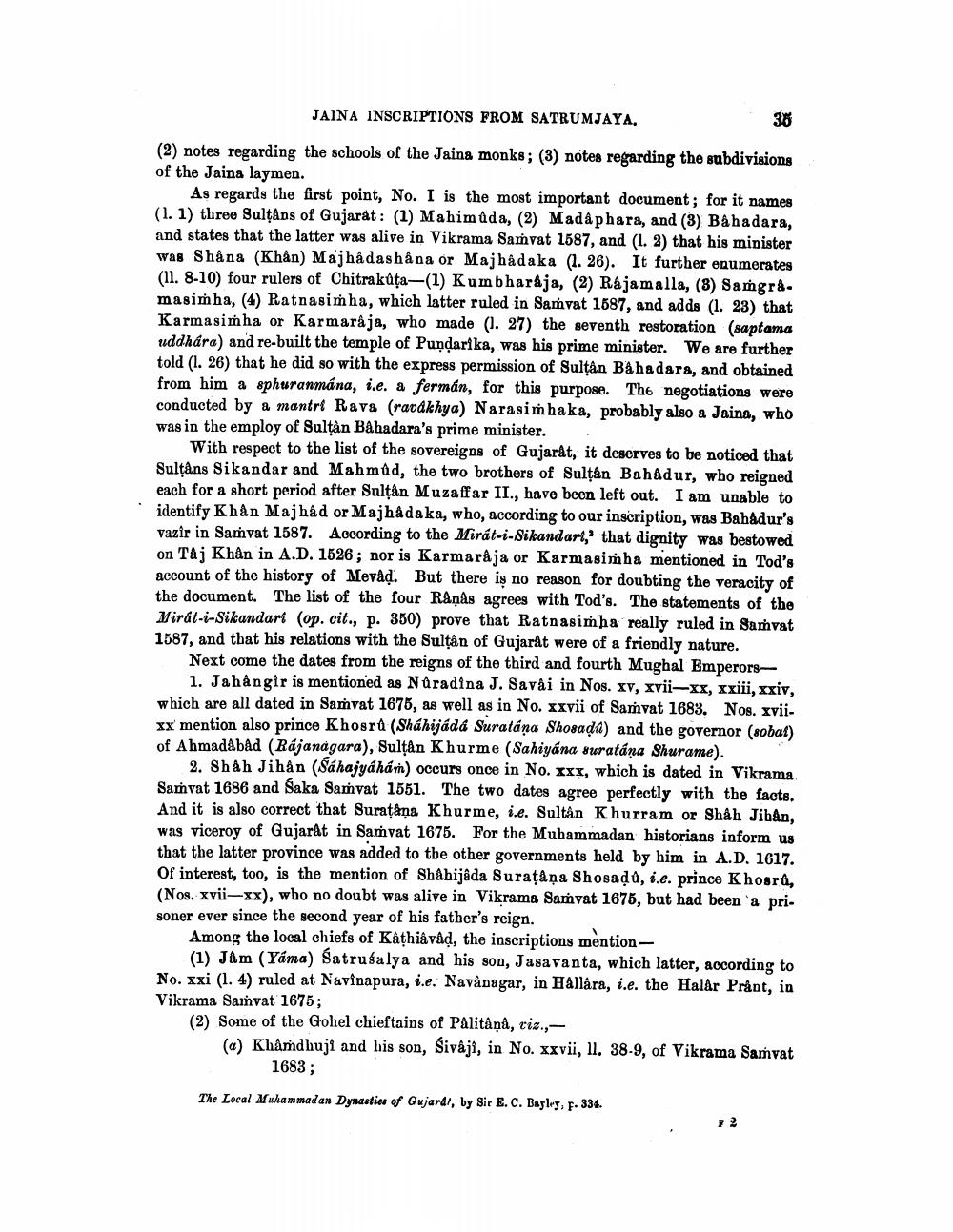________________
JAINA INSCRIPTIONS FROM SATRUMJAYA.
38
(2) notes regarding the schools of the Jaina monks ; (3) notes regarding the subdivisions of the Jaina laymen.
As regards the first point, No. I is the most important document: for it names (1.1) three Sultans of Gujarat: (1) Mahimůda, (2) Madâ phara, and (3) Bahadara, and states that the latter was alive in Vikrama Samvat 1587, and (1.2) that his minister was Shåna (Khân) Majhâdashána or Majhadaka (1. 26). It further enumerates (11. 8-10) four rulers of Chitrakuta—(1) Kumbharaja, (2) Rajamalla, (8) Samgrå. masiṁha, (4) Ratnasiṁha, which latter ruled in Samvat 1687, and adds (1. 23) that Karmasiṁha or Karmaraja, who made (1. 27) the seventh restoration (saptama uddhára) and re-built the temple of Pundarika, was his prime minister. We are further told (1. 26) that he did so with the express permission of Sultan Bahadara, and obtained from him a sphuranmána, i.e. a fermán, for this purpose. The negotiations were conducted by a mantri Rava (ravakhya) Narasimhaka, probably also a Jaina, who was in the employ of Sultân Bahadara's prime minister.
With respect to the list of the sovereigns of Gujarat, it deserves to be noticed that Sultans Sikandar and Mahmud, the two brothers of Sultan Bahadur, who reigned each for a short period after Sultan Muzaffar II., have been left out. I am unable to identify Khán Majhad or Majhada ka, who, according to our inscription, was Bahadur's vazir in Samvat 1587. According to the Mirát-i-Sikandart,' that dignity was bestowed on Taj Khan in A.D. 1526; nor is Karmaraja or Karmasimha mentioned in Tod's account of the history of Mevaď. But there is no reason for doubting the veracity of the document. The list of the four Rånås agrees with Tod's. The statements of the Mirat-i-Sikandart (op. cit., p. 350) prove that Ratnasimha really ruled in Samvat 1587, and that his relations with the Sultan of Gujarat were of a friendly nature.
Next come the dates from the reigns of the third and fourth Mughal Emperors
1. Jahangir is mentioned as Núradina J. Savai in Nos. XV, Xvii-XX, xxiii, xxiv, which are all dated in Samvat 1675, as well as in No. xxvii of Samvat 1683. Nos. xvii. XX mention also prince Khosra (Sháhijádá Suratána Shosada) and the governor (sobat) of Ahmadabad (Rájanagara), Sultan Khurme (Sahiyana suratána Shurame).
2. Shah Jihan (Sáhajyáhám) occurs once in No. xxx, which is dated in Vikrama Samvat 1686 and Saka Samvat 1551. The two dates agree perfectly with the facts. And it is also correct that Surațâņa Khurme, i.e. Sultân Khurram or Shah Jiban, was viceroy of Gujarat in Samvat 1675. For the Muhammadan historians inform us that the latter province was added to the other governments held by him in A.D. 1617. of interest, too, is the mention of Shahijâda Surațâna Shosada, i.e. prince Khosra, (Nos. xvii-xx), who no doubt was alive in Vikrama Samvat 1675, but had been a prisoner ever since the second year of his father's reign.
Among the local chiefs of Kathiâvad, the inscriptions mention
(1) Jam (Yama) Satrusalya and his son, Jasavanta, which latter, according to No. xxi (1. 4) ruled at Navinapura, i.e. Navânagar, in Hállára, i.e. the Halår Prânt, in Vikrama Samvat 1675; (2) Some of the Gohel chieftains of Palitàņa, riz.,(a) Khâmdhuji and his son, Sivaji, in No. xxvii, 11. 38-9, of Vikrama Samvat
1683;
The Local Muhammadan Dynastia of Gujard), by Sir E.C. Bayers, p. 334.




